Salmon en Papillote
Salmon en Papillote is an easy and satisfying recipe that’s perfect for a weeknight dinner. Fresh salmon fillets, vegetables, lemon, and herbs are cooked in parchment paper for a flavorful and aromatic meal!
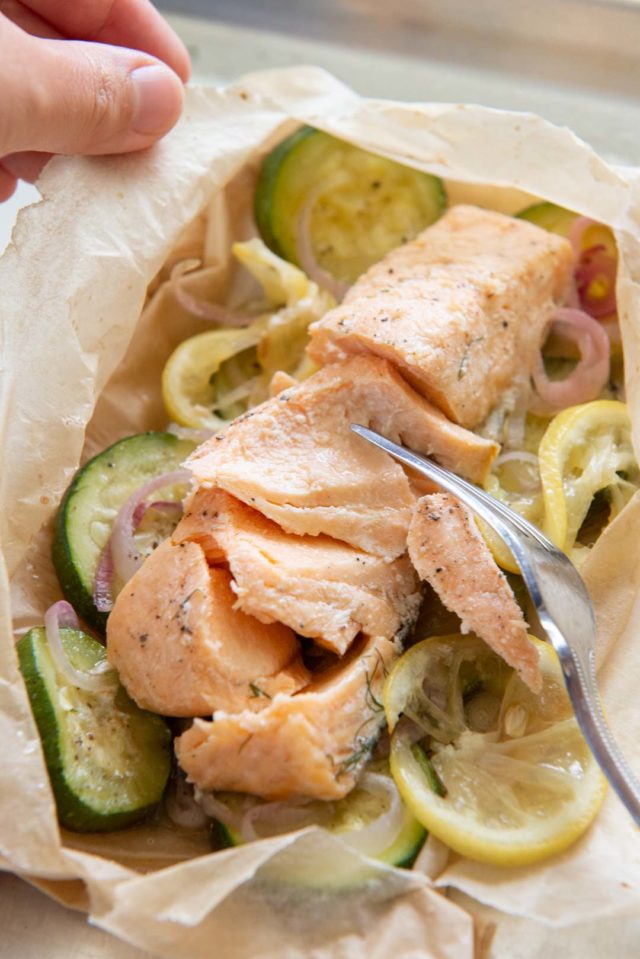
Good things happen when you seal a bunch of simple ingredients in a bag and let their aromas and flavors meld together.
I’m always taken aback every time I make this recipe and am reminded of how delicious it is.
It’s kind of like Baked Salmon, except everything gets wrapped tightly in parchment paper, sealing in a really fragrant steam that ends up flavoring everything inside the pouch.
The basic 5-ingredient formula here is:
- Salmon – Serves as the main protein for the dish. Other fish like mahi mahi or cod can be swapped in (see notes further down).
- Zucchini – Serves as the main vegetable. Other vegetables like haricot vert or asparagus can be swapped in (see more vegetable suggestions in the notes below).
- Shallot – A supporting vegetable and flavor that adds wonderful aroma to the steam.
- Dill – Incredibly compatible with salmon and provides amazing flavor and aroma to the parchment packet.
- Lemon – Provides acidity and also gives amazing aroma and flavor.
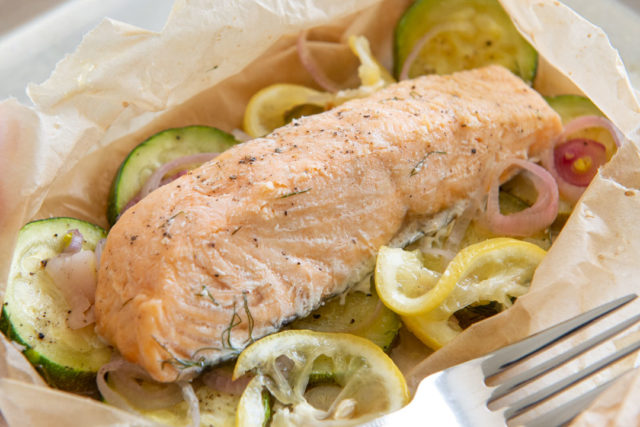
I like to season it all with salt and pepper, and add a drizzle of extra virgin olive oil, but otherwise, the ingredients here are quite minimal.
You can make an individual parchment paper packet for everyone in your family and bake it all at the same time on one sheet pan, or you can bake multiple portions in one packet.
I discuss and show this further down, but you can fold your own packet with a sheet of parchment paper, or you can buy parchment bags from the store.
Step by Step Overview:
Lay out a piece of parchment paper, and add sliced fresh zucchini, sliced shallots, and a drizzle of olive oil:
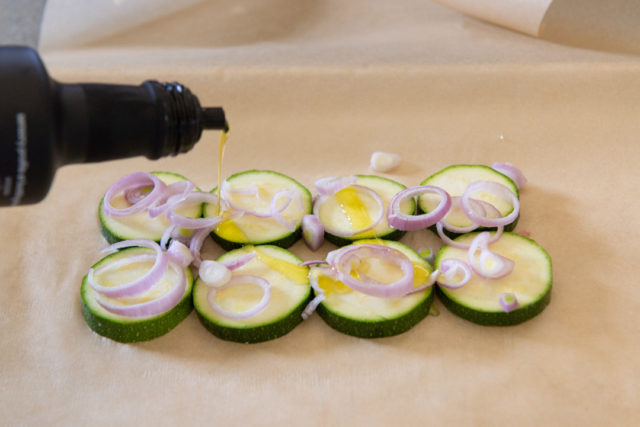
The optimal thickness for the zucchini to be tender but not completely mushy is somewhere between 1/4″ and 1/2″ thick.
Other Vegetables You Can Try
Zucchini is my favorite choice for the bed of vegetables, but you could also substitute haricot vert (extra thin green beans), fresh asparagus, mini sweet bell peppers, yellow squash, and bok choy.
Make sure you stick to the quicker cooking vegetables. Root vegetables like sweet potatoes or carrots would take too long to cook.
Season the zucchini with salt and black pepper, then add a 6-ounce salmon fillet portion and drizzle olive oil on that as well.
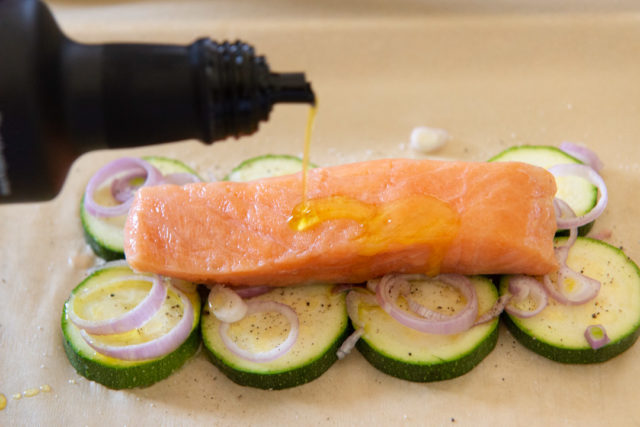
Other Types of Fish You Can Try
While salmon filets are my favorite, you can also experiment with substituting other kinds of fish like Mahi Mahi, Arctic Char, Snapper, Barramundi, and Cod.
Season the fish with kosher salt and fresh ground pepper, then add fresh dill on top:

Fresh dill is my favorite of the fresh herbs for salmon, but oregano is also a good choice.
Finally, lay some thinly sliced fresh lemon on top of the dill layer:
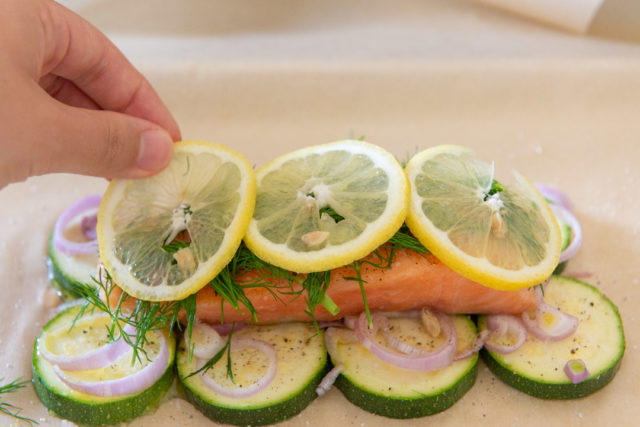
I love the look of the lemon slices on top, but they aren’t meant to be eaten in the final dish.
If that’s an issue for you, you can simply add a 1/2 teaspoon of lemon zest and 1 tablespoon of lemon juice on top of the salmon.
That’s it for the ingredients. Time to seal the parchment!
Three Ways to Crimp the Parchment Paper Shut:
Folding Style #1: For my favorite method, I prefer to use a 13″ x 16″ pre-cut rectangular sheet of parchment paper (affiliate), then fold the long edge over a few times, as shown below:
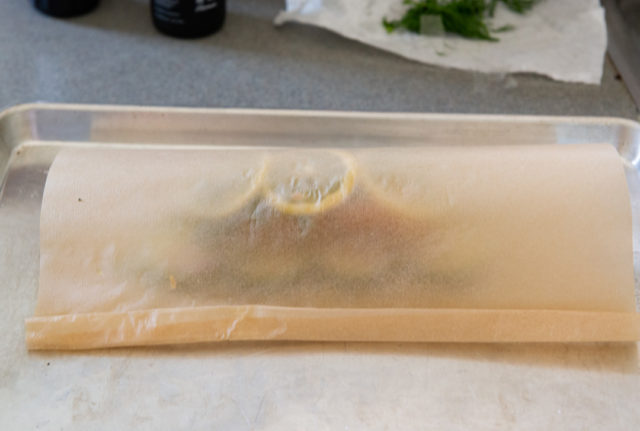
Once the long edge is done, fold in the sides of the parchment sheet:
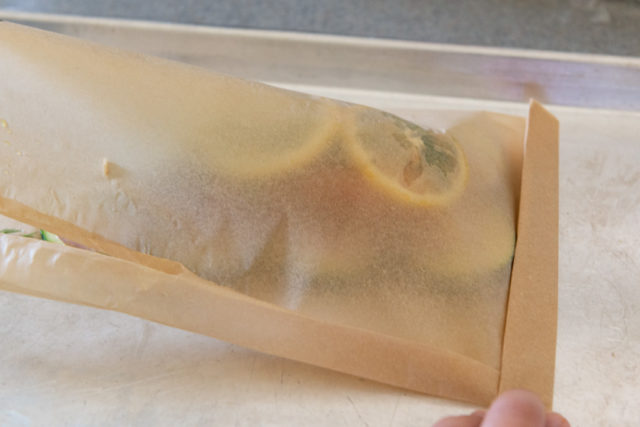
Then, to make sure the edges don’t come undone, I tuck them underneath, so that the weight of the fish and ingredients holds the parchment paper pouch ends down:
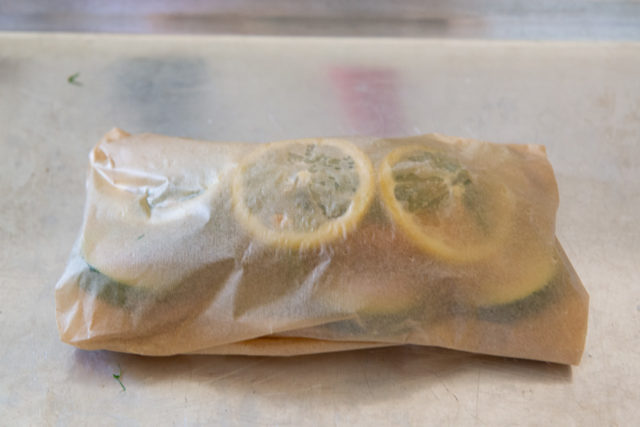
Folding Style #2: You can take the same rectangular sheet of parchment paper, and repeatedly fold in the edges in a half moon shape.
In this case, the crimping holds pretty well, so you don’t have to tuck the paper underneath the fish.
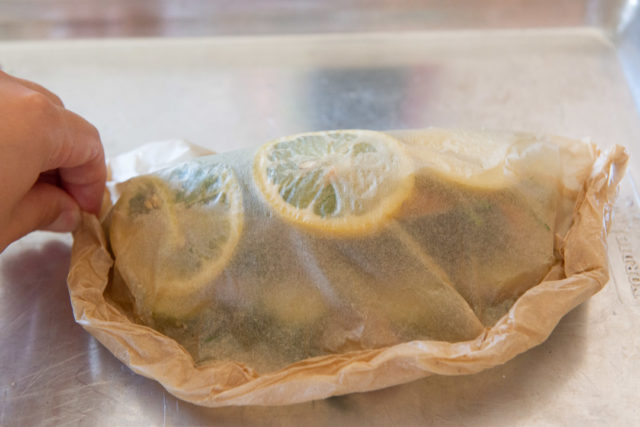
I don’t like the look as much but this is merely personal preference.
Folding Style #3: Parchment Bags are sold at most grocery stores now. You can see below, it’s a big bag that you can put in fish, meats, etc, then simply fold the end over a few times:
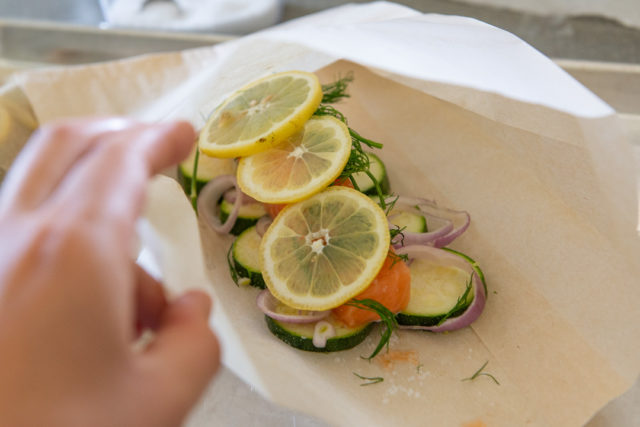
I tested out some of these bags, but still prefer using a rectangular sheet of parchment paper because it’s harder to properly season the ingredients and layer them. But I realize this may be personal preference as well.
Make Sure the Parchment Paper is Well Sealed
Regardless of which Folding Method or Bag you use, really make sure the ends are folded tightly.
Trapping in all of the flavors and aromas during cooking is the whole point of roasting the fish and vegetables in the parchment paper.
How Long to Bake
At a 350F temperature, you’ll want to bake the pouches on a baking sheet for 15-20 minutes, depending on the thickness and size of your salmon.
If you have a really thin piece of salmon, which is more common with wild salmons like sockeye, you will be on the low end, and I’d aim for 15 minutes. I like to stop cooking when the interior is 125F, which is medium.
20 minutes is more typical for most pieces of salmon. You can see my piece of farmed salmon was quite thick.
Tear open the parchment paper at the table, and enjoy the aromas. It’s one of my favorite parts!
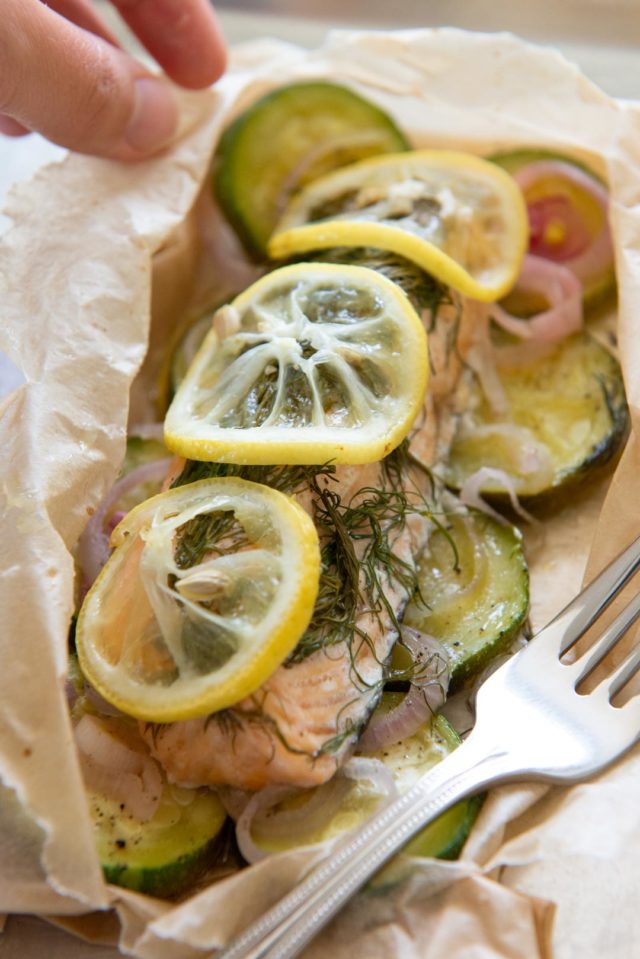
Make Ahead Instructions:
You can assemble all the raw ingredients in the pieces of parchment paper and keep them in the fridge on a sheet pan until you are ready to bake, up to 6 hours ahead of time.
I recommend taking the pan out of the fridge 15 minutes before baking, and letting sit at room temperature. That way the ingredients aren’t quite as cold when they go into the oven.
Special Diets: This recipe is dairy-free, gluten-free, Whole30 compliant, paleo, and keto friendly.
Pan Seared Salmon, Salmon Salad, and Salmon Cakes are a few more of my favorite Salmon recipes. Enjoy!
FAQ and Tips:
I recommend you DO NOT store the slices of lemon with any leftovers, as they will continue to impart very strong flavor on the fish and vegetables. After cooking, discard the lemon. You can keep leftovers in the fridge for up to 2 days.
Yes, in an airtight container for up to 3 months. Thaw in the fridge overnight before reheating.
Recipe Variations
Instead of drizzling olive oil over the fish and vegetables, try adding a compound butter with garlic and herbs.
Add 1 tablespoon of a dry white wine to each of the parchment packets before cooking for extra aroma and flavor.
More Fish and Seafood Recipes:
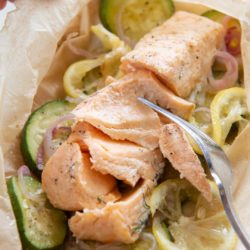
Salmon en Papillote
Ingredients
- 1 large zucchini sliced between 1/4" and 1/2" thick
- 1 shallot thinly sliced
- 1/4 cup extra virgin olive oil
- 2 6-ounce pieces of salmon
- 1/2 cup fresh dill
- 1 lemon thinly sliced
- kosher salt
- freshly cracked pepper
Instructions
- Preheat the oven to 350 degrees F.
- Lay out two pieces of 13"x16" pre-cut parchment paper.
- Arrange a single layer of zucchini slices on each piece of parchment paper, big enough for the fish to sit on (I usually do 8 slices of zucchini each). Sprinkle over the sliced shallots. Drizzle each zucchini parchment serving with 1 tbsp of olive oil, then season with salt and pepper. I do this by eye, but 1/8 tsp of each should be sufficient.
- Place one salmon piece on each zucchini layer, drizzle with the remaining olive oil, and season with salt and pepper as well. 1/4 tsp of salt for each salmon fillet is a good starting point.
- Arrange the dill on top of the salmon, and cover with a single layer of fresh lemon slices.
- Seal the parchment paper well by repeatedly folding the ends over each other, taking care to make sure it is well sealed. You don’t want any steam to escape. See blog post for photos.
- Bake for 15-20 minutes, depending on the thickness and size of your salmon. I recommend cooking the salmon to medium doneness, at 125F. You can check the salmon by poking the thermometer through the paper, but try not to open the paper up completely.
- Plate the entire packet on plates, still sealed, then tear open the parchment paper at the table to full savor the aromas. Enjoy!
Notes
Nutrition
Nutrition is estimated using a food database and is only intended to be used as a guideline for informational purposes.
Post updated in August 2020. Originally published May 2013.

37 Comments on “Salmon en Papillote”
Made this for dinner tonight. Used green onions and dried dill. Also bought frozen salmon. Thawed it out and squeezed out as much water as possible. It way exceeded my expectations.
I made this on Friday night. Absolutely De-Lish! Tender, juicy and flavourful! It is definitely one I will make again. Used Steelhead Trout, btw, instead of the salmon.
This was shockingly good. I wasn’t expecting a lot because the ingredients are so minimal but the flavors were lovely.
I enjoy it Asian style with soya sauce and Thai fish sauce, and maybe a dollop of sriracha! Yum
That sounds fantastic!
Gave it a go, and really liked it. This has to be one of my new favorite cooking options.
So glad you enjoyed the dish!!